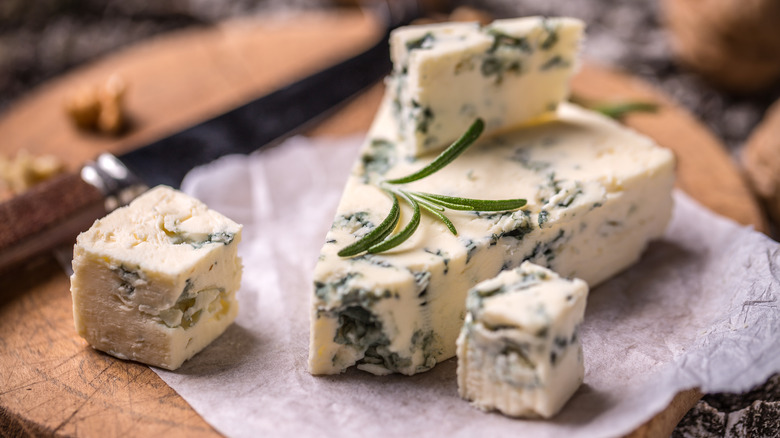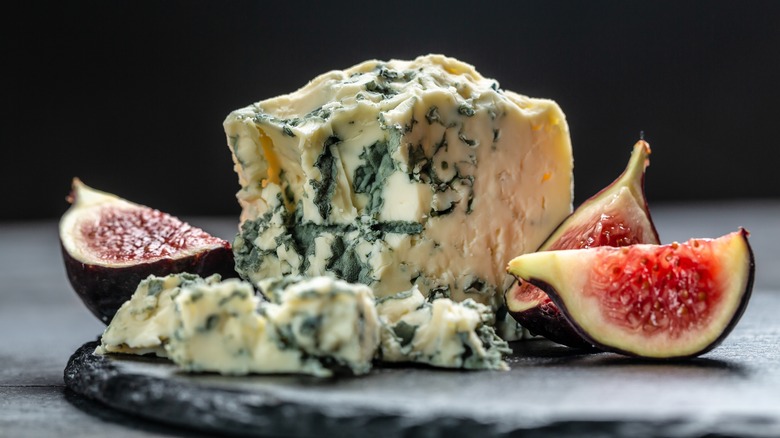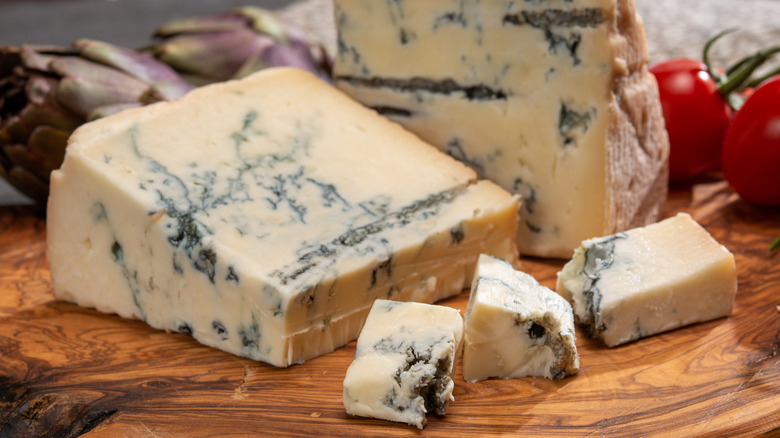The Scientific Reason Blue Cheese Is Moldy But Safe To Eat
Seeing mold on food, or even worse, taking a bite before you've spotted it and then tasting that distinctive wet-dirt flavor, is one of those things that naturally provokes feelings of disgust in most people. We tend to associate those gray furry patches or dark blue-green spots that appear on food with harmful bacteria or fungi that might make us sick. So what's the deal with blue cheese, which appears to be moldy on purpose?
While some types of mold are dangerous, and nobody likes the thought of accidentally eating mold, other kinds are not a risk, and can even be beneficial (via USDA). So while blue cheese is indeed moldy, and very deliberately so – it gets its very name from the blue veins that run through it — it is perfectly fine to eat thanks to the variety of mold used in its production.
Not only is the mold in blue cheese safe to consume, but it's also pretty much responsible for its distinctive taste and aroma. As with other types of cheese, such as Minger, the smelliest cheese in the world, it's the flourishing bacteria that create the very characteristics that define it. Making blue cheese is a complex process, and cultures from a certain type of mold are added specifically to enhance the dairy product's sharp and savory flavor, as well as give it its instantly recognizable appearance.
Penicillium fungi create the blue veins in cheese
Some types of mold can produce mycotoxins, compounds which, as the name suggests, can be toxic if ingested. But the blue veins you'll see in most widely available blue cheeses are caused by spores from varieties of Penicillium, which comes from the same family as that used to make the antibiotic medicine Penicillin; these varieties of mold do not produce toxins. The type of Penicillium used depends on the cheese in question.
Penicillium roqueforti is responsible for the blue streaks that run through one of the oldest blue cheeses, Roquefort. Tangy and salty along with a signature sharp-yet-creamy flavor, this funky French cheese, which is made from ewe's milk, works perfectly in umami-rich recipes such as a Roquefort and mushroom fondue. The same mold is used in cow's milk blue cheeses, such as English Stilton cheese, and Danish Blue. The defining mold of Italian Gorgonzola, meanwhile, is the related Penicillium glaucum, which gives it its distinctive look and earthy flavor.
So how does blue cheese get so moldy? After the whey has been drained, as the curds are pressed into wheel shapes, the blue cheese mold is added, and then the cheese is set aside to mature. During this aging process, the cheese is pierced to make holes, which allow oxygen in. This encourages the mold to spread along the air holes, creating the unique vein-like patterns throughout the cheese.
Can blue cheese still go off if it's already moldy?
Given that blue cheese is already moldy, does that mean once you've bought some and got it home, it is immune from turning bad? Perhaps unsurprisingly, the answer is no since, again, not all mold is the same. While you want to see the intentional blue or green veins running through a creamy-colored wedge, you don't want to see fuzzy white patches, gray spots, or yellow areas spreading on the surface, and it certainly shouldn't look in any way slimy.
Storing blue cheese correctly will help extend its shelf-life, and make it enjoyable to eat longer in tasty recipes such as extra-savory broccoli and blue cheese soup. Airtight plastic wrap, which some stores sell the product in, encourages cheese to become sweaty. So to avoid moisture building up (an environment that helps bad mold develop faster), it's best to re-wrap it in parchment and then in something like beeswax paper, so it can breathe better.
You'll also want to keep any blue cheese away from the other varieties of cheese in your refrigerator — to prevent mold from spreading; perhaps try a separate container, allowing the air to still get to it, but so it doesn't risk contaminating anything else. If stored correctly, blue cheese should last for around three to four weeks in the coolest and driest area of the fridge — think the top shelf.



